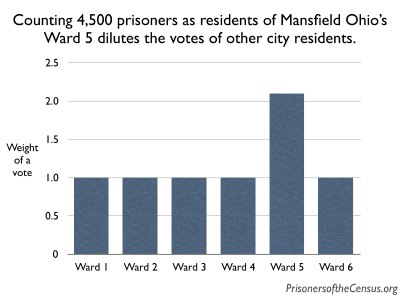Cities with large prisons: Counting prisoners as residents dilutes democracy in Mansfield Ohio
by Peter Wagner, September 29, 2003

Mansfield, Ohio is a small city with 6 city council wards of approximately 8,600 residents each. The problem? Two large prisons (Mansfield Correctional Institution and Richland Correctional Institution) are both in the 5th Ward and their populations were counted as residents of the ward.
The City’s law director advocated for a redistricting plan that would at least split the prisons into two different districts, complaining that “Deanna [Torrence of the 5th Ward] is only representing 3,000 people (who actually can vote).” The City decided to keep the districts as-is.
The best solution for the city would have been to exclude the prisoners from the redistricting process as the majority of the prisoners are from outside Mansfield and its Ward 5. Only 1.26% of Ohio’s prisoners are from Richland County (564 prisoners), with a smaller portion being from Mansfield and an even smaller portion from Ward 5.
It makes no sense to use Census counts of state prisoners to divide up political power within the City of Mansfield. Of course, the best solution would be for the Census to count prisoners at home, not at temporary prisons.
Sources: Linda Martz, Taxpayers before wards, Mansfield News Journal (Mansfield, OH) November 26, 2002, p. 6A; U.S. Census, Ohio Department of Corrections and Rehabilitation.



